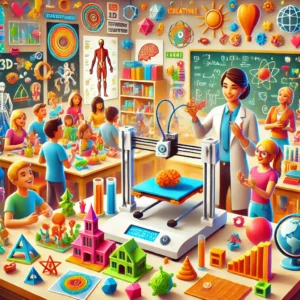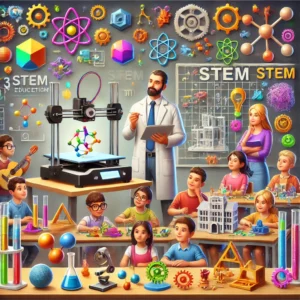Uncover the amazing ways 3D printing is transforming learning! Perfect for teachers, students, and hobbyists, 3D printers are making educational experiences hands-on, exciting, and engaging. Discover how you can bring biology, history, math, and more to life right in your classroom or at home with the help of 3D printing technology!

The Power of 3D Printing in Education
Picture this: A biology student holding a human heart model, exploring its chambers and arteries in stunning, intricate detail. A history student examining a lifelike replica of an ancient artifact without ever needing to leave the classroom. Or a young hobbyist at home, experimenting with models of architectural wonders or complex molecules. 3D printing technology is making these experiences possible for students, educators, and enthusiasts everywhere, changing the face of learning.
In recent years, 3D printing has shifted from a complex, expensive technology reserved for professionals to an accessible, versatile tool used in schools, universities, and homes worldwide. 3D printers, like the affordable and beginner-friendly KingRoon 3D Printers, have made it easier to bring creativity and learning to life with just the click of a button. As students and hobbyists explore everything from science and history to art and design, 3D printing transforms education by turning abstract concepts into tangible, interactive experiences.
In this comprehensive guide, we’ll dive into how 3D printing revolutionizes education, from classrooms to living rooms, and how you can harness its power to enrich your learning journey.
What is 3D Printing and Why is it Exciting for Education?
Let’s start with the basics. 3D printing, also known as additive manufacturing, is a process that builds objects layer by layer using materials like plastic, metal, and resin. This technology reads a digital file—such as a 3D design or model—and transforms it into a solid object by adding thin layers on top of each other until the piece is complete. Think of it as building with LEGO blocks but on a micro level!
So, why is this exciting for education? Traditional teaching methods often rely on visual aids, illustrations, or verbal descriptions, which can be limiting, especially for complex subjects like anatomy, geometry, or chemistry. 3D printing shatters those limitations by allowing teachers and students to create models, tools, and even prototypes that they can interact with physically. Here’s why it’s transforming learning for the better:
- Interactive Learning: Learning is no longer just about reading or watching. With 3D printing, students can see, touch, and interact with models, making concepts like molecular structures or architectural forms far more accessible to understand.
- Cost-Effective and Customizable: Instead of purchasing expensive educational kits or pre-made models, teachers can create and customize specific models tailored to the lesson, making learning highly adaptable.
- Enhanced Engagement: Research shows students are more engaged and motivated when interacting with hands-on materials. The novelty and creativity in 3D printing make lessons feel like play, even educational ones!

How 3D Printing is Making Science More Tangible
Biology and Anatomy
One of the biggest beneficiaries of 3D printing is biology, especially in fields like anatomy. Studying body systems and organs from flat illustrations is challenging. Still, with 3D models, students can explore the human body up close. Imagine holding a life-sized model of the heart, complete with all its ventricles, arteries, and valves. It’s a game-changer for understanding the structure and function of body systems.
Here are a few ways 3D printing benefits biology:
- Organ Models: Students can examine accurate models of organs, helping them understand their structure and relationships within the body. 3D-printed models of the brain, lungs, or kidneys can be manipulated, making the learning experience immersive and memorable.
- Bones and Muscles: For students studying bones and muscles, handling 3D-printed replicas of the skeletal system clarifies how these structures connect and work together.
- Microscopic Models: Even bacteria, viruses, and cells, typically studied under a microscope, can be scaled up with 3D printing, giving students a close-up look at their structures and functions.
Chemistry and Physics
Visualizing molecular bonds, atomic structures, and chemical reactions in chemistry requires significant imagination. 3D printing can bring these invisible phenomena into the physical world, helping students see the relationships between atoms and bonds.
Here’s how 3D printing enhances chemistry and physics education:
- Molecular Structures: Instead of relying on diagrams, students can hold models of molecules, like water or glucose, allowing them to explore bonding, angles, and shapes.
- Periodic Table and Atom Models: Teaching the periodic table or atomic structures becomes much easier when students can hold elements and see how they connect.
- Physics Concepts: Physics teachers can print models of mechanical parts, tools, and even components of simple machines to help students understand concepts like force, gravity, and momentum.
Earth Science and Astronomy
From studying the layers of the Earth to analyzing distant planets, 3D printing brings an extra dimension to Earth science and astronomy.
- Geological Models: Students can examine 3D-printed models of mountain ranges, tectonic plates, or fault lines, seeing how natural forces shape the planet.
- Planetary Models: Astronomy becomes more interactive with 3D models of planets, moons, and stars. Students can easily explore our solar system, understanding planetary relationships and sizes.
Bringing History to Life with 3D Printing
History is filled with artifacts, monuments, and relics that connect us to the past. But in most classrooms, these invaluable objects remain behind glass cases or thousands of miles away in museums. 3D printing changes that by allowing teachers to recreate artifacts and structures that students can study firsthand.
Recreating Artifacts and Ancient Structures
Imagine holding a replica of the Rosetta Stone or a miniature version of the Great Wall of China. With 3D printing, students can study these significant cultural and historical pieces closely, analyzing every detail like ancient times.
- Artifact Replicas: Teachers can create replicas of historic items like pottery, statues, or tools used by ancient civilizations, allowing students to gain a tangible sense of history.
- Cultural Artifacts: Printing models of cultural symbols or religious relics helps students understand the heritage and beliefs of ancient societies respectfully and meaningfully.
Visualizing Historical Events
Some teachers use 3D printing to illustrate historical events more vividly. Imagine a battlefield model, complete with terrain and landmarks, that can be used to teach about the movements and strategies of historic battles.
- Battle Maps and Topography: Recreate the terrain of famous battles, showing students how geography affected historical outcomes.
- Historical Structures: Models of castles, temples, and fortresses allow students to explore the architecture and significance of these ancient structures without needing to visit them in person.
Making Mathematics Concrete with 3D Printing
Mathematics sometimes feels abstract, especially in three-dimensional shapes, complex formulas, or graphing. However, with 3D printing, math becomes something students can see and hold.
Geometry and Shapes
Geometry is one of the most natural applications of 3D printing. Instead of visualizing shapes and forms on paper, students can explore them in real space.
- Geometric Solids: Teachers can print out geometric solids like cubes, spheres, and pyramids, helping students understand their properties and measurements firsthand.
- Angles and Dimensions: By exploring models, students can more easily see relationships between different angles, dimensions, and surfaces, making it easier to understand theorems and proofs.
Algebra and Graphing
Algebra can also become more accessible with 3D-printed models. When students can visualize graphing concepts, it helps make connections between algebraic functions and their real-world implications.
- Function Models: Teachers can create models of algebraic functions—like parabolas or ellipses—that students can hold, showing how equations relate to shapes.
- Data Visualization: Printing 3D representations of data sets, such as histograms or scatter plots, adds a tangible element to understanding statistics and probabilities.
The Rise of 3D Printing in Art and Design Education
Art and design classes embrace 3D printing as a tool and a new creative medium. Students are learning to blend technology with artistry, using 3D printers to push the boundaries of design.
Sculpture and Installation Art
3D printing allows art students to explore sculpture in ways traditional methods can’t. It’s a flexible medium, ideal for creating intricate designs that are difficult to achieve by hand.
- Design Freedom: 3D printing allows students to explore forms and structures that might be challenging to create with traditional materials, sparking innovation.
- Prototype Testing: For artists, designers, and architects, 3D printing allows rapid prototyping. Students can create test pieces for larger projects, experimenting with size, form, and proportion before committing to a final design.
Fashion and Accessories
Fashion students also experimented with 3D printing to create innovative designs, from clothing accessories to wearable tech.
- Jewelry Design: Fashion students can design and print intricate jewelry pieces, exploring new styles and trends without the high cost of traditional production.
- Custom Patterns and Textures: With 3D printing, designers can produce textured fabrics or accessories that integrate seamlessly with traditional materials.
Developing Problem-Solving Skills with 3D Printing Projects
Learning to 3D print exercises creativity, patience, and problem-solving. From concept to creation, students learn how to plan, execute, and refine their designs, often dealing with unexpected challenges.
Project-Based Learning with 3D Printing
Project-based learning (PBL) uses real-world problems to engage students meaningfully. 3D printing naturally supports this approach, encouraging students to create tangible solutions to real-life problems.
- Practical Applications: Students can design solutions for specific challenges, such as creating accessible tools or devices for people with disabilities.
- Iterative Learning: As students prototype, test, and refine their designs, they gain an understanding of the engineering design process, learning that failure is simply a step toward improvement.
Teamwork and Collaboration
Working on 3D printing projects in groups can help students develop soft skills like communication, teamwork, and conflict resolution.
- Group Projects: Students might tackle large projects, divide tasks, and work collaboratively to build a more complex model.
- Communication Skills: Collaborative 3D printing projects require students to articulate their ideas, listen to others, and give constructive feedback, improving interpersonal skills.
Why KingRoon 3D Printers Are Perfect for Home and Classroom Use
KingRoon 3D Printers have gained popularity among beginners and hobbyists, and for good reason. Affordable, easy to use, and highly reliable, KingRoon printers are a fantastic choice for educational settings and home learners.
Why Choose KingRoon?
- Affordability: KingRoon provides budget-friendly models without sacrificing quality, making it easier for schools, educators, and parents to introduce 3D printing.
- User-Friendly Design: With simple assembly and intuitive controls, KingRoon printers are designed for ease, meaning teachers and students can focus on learning instead of troubleshooting.
- Compact and Portable: KingRoon printers are compact, saving valuable classroom or home space, yet they still offer the precision needed for detailed prints.
- Quality and Precision: Although affordable, KingRoon printers produce precise and consistent models ideal for educational purposes.
Getting Started with 3D Printing at Home or in School
Are you excited to bring 3D printing into your classroom or home? Here are some practical steps for getting started, even if you’re a beginner.
Tips for Teachers and Hobbyists
- Choose the Right Printer: KingRoon printers are perfect for beginners and offer a balance of quality and affordability.
- Start with Simple Models: Begin with simple shapes or objects to learn the basics before moving on to more complex designs.
- Use Online Resources: Platforms like Thingiverse or Tinkercad offer free, ready-to-print models and tools for creating designs.
- Experiment and Explore: Don’t be afraid to make mistakes. 3D printing is about learning through doing, which is highly rewarding!
With the endless possibilities of 3D printing, education is becoming more interactive, engaging, and imaginative than ever before. Whether you’re a teacher, student, or hobbyist, this technology invites you to explore, create, and transform how we learn, one layer at a time.
Limited time sale for all 3D printers, starting from 125USD Code–>>. “Printer3%”
KingRoon 3D Printers Sale – High-performance 3D Printers—>> SHOP NOW!
Bullwinkle


